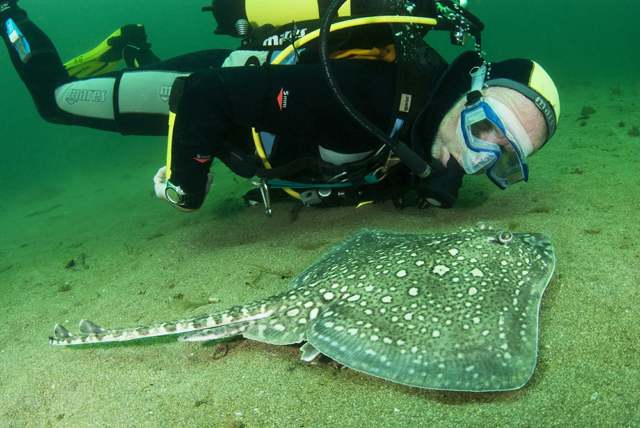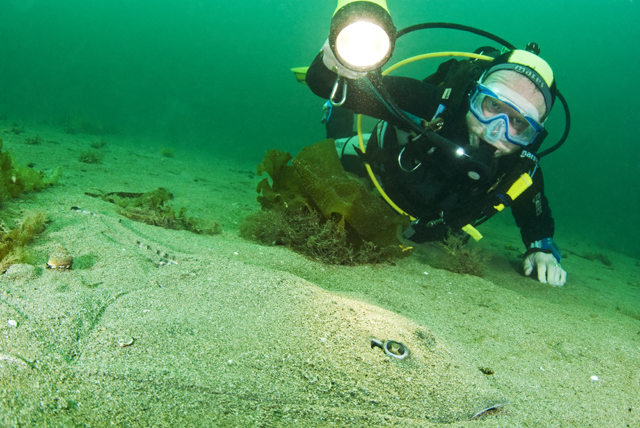News
Have a Ray Day
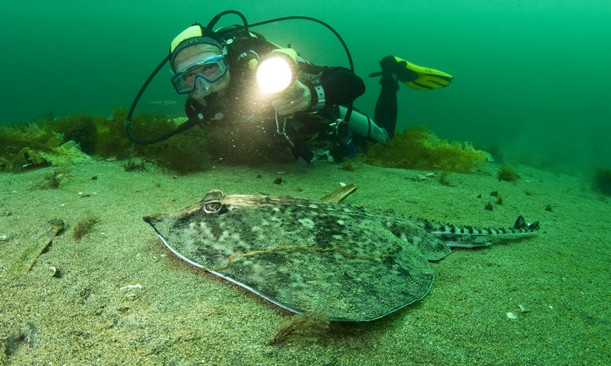
Mike Anselmi, the owner of Porthkerris Dive Centre in Cornwall, said that the Helford River Estuary is one of the most popular dive sites in the area. The shallow seabed attracts all sorts of interesting marine life including Sea Hares, Cuttlefish, Clams, Scallops, Hermits and Blonde Rays. May through to August is peak season for Thornback Ray (Raja clavata) sightings. Mike said that the Rays congregated in larger numbers around mid-August. During this time it’s not unusual to see at least 5 or 6 different individuals on a single 1 hour long dive. The Rays stick together in loose packs, so when one is sighted there are usually others somewhere close by.
This is a unique underwater experience and gives divers and photographers the perfect opportunity to get up close and personal with these creatures. It’s even possible to swim side by side as they effortlessly ‘fly’ across the seabed. Thornbacks shouldn’t be confused with their close relatives, Sting Rays. They are totally non-aggressive and pose no threat to divers. There are no lethal looking barbs protruding from the tail. Instead they have 30-50 spines along the tail and up the back which could potentially give someone a graze but only if the Ray is grabbed or picked up. The mouth is located on the white coloured underside. This has rows of very small teeth which make perfect tools for crunching on Crabs, Prawns and Flatfish – not divers.
The Charter Boat
Mike has been running the family business for more than 22 years. He owns 2 hard boats and a twin engined RIB. We went out on Mike’s flagship, the 14 metre long Celtic Cat. Getting onto the boat is quite a novel experience. There is no jetty, so divers have to walk along a high rise gangplank which is then pushed into the sea by a Tractor. Mike’s other hard boat, the smaller 8 metre long Celtic Kitten, has a bow ramp so it can come right up to the beach. Celtic Cat has plenty of room onboard for kitting up and gear stowage. The boat also has a big enclosed cabin area and an inner sanctum where I could get hot drinks. Mike has fitted a double diver lift on the stern which is controlled by CCTV linked to the high rise Bridge. Mike normally offers the Thornback Ray dive as and when he’s asked. He said that the Rays come closer inshore during calm weather; they don’t like choppy seas.
Arrival at the site
Porthkerris Dive Centre is located way down on the South West Coast of Cornwall near the Lizard. RNAS Culdrose is a good landmark to aim for and then follow the signs to St Keverne. The last few miles can be quite confusing (I took the wrong turning, duh!) but there’s still a mobile signal for any ‘help, I’m lost’ SOS calls to the dive centre. When I started seeing the Basking Shark (this is the other big attraction) signs I knew I was on the right track. The narrow hedge-lined lanes eventually open out onto a very picturesque little bay. The new dive centre building is located right next to the pebble beach. On-site facilities include a dive shop, 2 camp sites, toilets, cafe, car park, gas fills and plenty of shore diving possibilities. There are even a number of Pubs close by. The local Seal sanctuary located at Gweek is also worth a visit during off gassing periods.
Pre-dive briefing
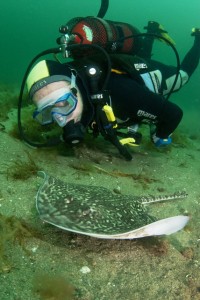
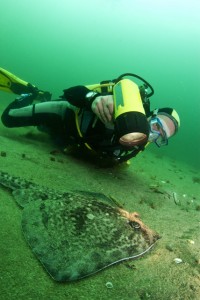 The Helford River is about 20 minute’s boat ride from Porthkerris Dive Centre. At high water it’s around 12 metres deep at the river mouth and 8 metres further up the estuary by the boat moorings. The seabed is made up of sand and shingle in the central channel. Nearer the edges and further up the estuary this changes to a maerl-like composition interspersed with patches of weed (perfect for Scallops).
The Helford River is about 20 minute’s boat ride from Porthkerris Dive Centre. At high water it’s around 12 metres deep at the river mouth and 8 metres further up the estuary by the boat moorings. The seabed is made up of sand and shingle in the central channel. Nearer the edges and further up the estuary this changes to a maerl-like composition interspersed with patches of weed (perfect for Scallops).
There can be strong currents, so it’s best to dive a few hours before high water on the flood tide when things are calming down. The visibility will be better and there is more chance of seeing Thornback Rays. Keep a close eye on air supplies, as chasing after Rays can be quite a tank-draining exercise. All divers should carry a delayed SMB. Mike asks that they are deployed at the end of the dive before commencing any safety stops. This is a busy waterway so be extra vigilant on ascents. Propeller haircuts are not advisable.
Mike dropped us in the middle of the channel right by the River mouth. The tide was still flooding which meant that the current would take us inside the channel rather than out to sea. We would also have ‘cleaner’ water for my photographs. We made a free descent without reference to the seabed. The Rays are not in any particular area so there is no set direction to take, it’s basically pot luck. We drifted along with the current scanning the seabed for any Ray like shapes.
The Dive
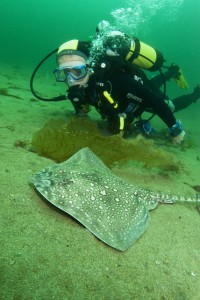 Creeping up on Thornback Rays turned out to be easier than I expected. I had brought along Brian Hayes, a diving friend of many years, to act as ‘model’ and Ray spotter. We found our first Ray in the first 2-3 minutes of our dive. I could make out the diamond shaped outline hidden under the sand. A pair of eye stalks and a sharp pointy nose were the only parts visible. I guess this was in readiness to strike at any prey that unwittingly wandered into the kill zone.
Creeping up on Thornback Rays turned out to be easier than I expected. I had brought along Brian Hayes, a diving friend of many years, to act as ‘model’ and Ray spotter. We found our first Ray in the first 2-3 minutes of our dive. I could make out the diamond shaped outline hidden under the sand. A pair of eye stalks and a sharp pointy nose were the only parts visible. I guess this was in readiness to strike at any prey that unwittingly wandered into the kill zone.
Working as a team we managed to get within touching distance of around 5 or 6 different Rays on each dive. The Rays seemed to react differently depending on the tide conditions. While the tide was still flooding they were more active and on the move. Mike thinks this is when they are feeding. On 3 occasions we had to swim like lunatics just to keep up. When there was very little tide we found 2 or 3 different Rays buried in the sand and they were very easy to approach – in fact, I could have touched them with my camera dome and they still wouldn’t have budged. I even got Brian to do a ‘Steve Irwin’ manoeuvre over the top of a Ray for a close-up head shot and there was still no reaction. Maybe the Ray thought that its camouflage was so good we couldn’t see it.
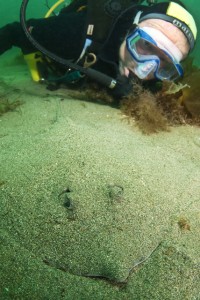 As the tide turned there seemed to be less Rays about and they were moving much more slowly. We had also moved up the estuary nearer to the boat moorings. The seabed composition had changed and there were far more Sea Hares around. We swam along with one particular Ray for a good 5 minutes and then bumped into a very photogenic Cuttlefish. None of the Rays shot off in an erratic manner or seemed distressed by our presence. Considering they were being sandwiched by 2 divers this was quite surprising.
As the tide turned there seemed to be less Rays about and they were moving much more slowly. We had also moved up the estuary nearer to the boat moorings. The seabed composition had changed and there were far more Sea Hares around. We swam along with one particular Ray for a good 5 minutes and then bumped into a very photogenic Cuttlefish. None of the Rays shot off in an erratic manner or seemed distressed by our presence. Considering they were being sandwiched by 2 divers this was quite surprising.
The Thornbacks we encountered varied in size from small 20cm wingspans to much bigger 50cm plus specimens. The colour schemes were usually grey or brown with a kaleidoscope pattern of spots and splodges on the topside. Most had 2 claspers dangling from the tail area meaning they were males. We only encountered one small female. Average recorded sizes are around 60 cm and weigh in at 3 or 4kg’s. They can grow to more than a metre in length and weigh over 15kg’s.
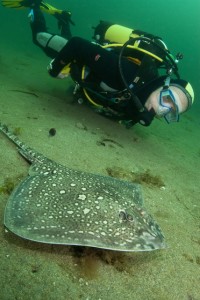 This has to be one of the best marine life dives in the UK and it’s at a shallow depth where every level of diver can safely join in the fun. Our close encounters were totally natural. There was no provocation or feeding enticements going on in the background. They say a picture paints a thousand words so hopefully my photographs show just how close we managed to get. With rather more luck than judgement we had chosen a perfect day for weather. There was plenty of sunlight and very little wave action to worry about. Underwater visibility was around 8 metres throughout and the current took away any kicked up silt during our power finning spurts. For once I actually had to admit this was pretty good going for UK conditions. The toughest part of the day was keeping my model focused on the job in-hand. Brian was getting more and more distracted by the number of decent sized Scallops scattered over the seabed. He even had his goody bag at the ready!
This has to be one of the best marine life dives in the UK and it’s at a shallow depth where every level of diver can safely join in the fun. Our close encounters were totally natural. There was no provocation or feeding enticements going on in the background. They say a picture paints a thousand words so hopefully my photographs show just how close we managed to get. With rather more luck than judgement we had chosen a perfect day for weather. There was plenty of sunlight and very little wave action to worry about. Underwater visibility was around 8 metres throughout and the current took away any kicked up silt during our power finning spurts. For once I actually had to admit this was pretty good going for UK conditions. The toughest part of the day was keeping my model focused on the job in-hand. Brian was getting more and more distracted by the number of decent sized Scallops scattered over the seabed. He even had his goody bag at the ready!
Blogs
The Ocean Cleanup Breaks 10,000,000 KG Barrier

The Ocean Cleanup, the global non-profit project, has removed a verified all-time total of ten million kilograms (22 million lbs.) of trash from oceans and rivers around the world – approximately the same weight as the Eiffel Tower.
To complete its mission of ridding the oceans of plastic, The Ocean Cleanup uses a dual strategy: cleaning up the Great Pacific Garbage Patch (GPGP) to remove the plastic already afloat in the oceans, while stopping the flow of plastic from the world’s most polluting rivers.
Through cleaning operations in the GPGP and in rivers in eight countries, the cumulative total of trash removed has now surpassed ten million kilograms. This milestone demonstrates the acceleration of The Ocean Cleanup’s impact, while underlining the astonishing scale of the plastic pollution problem and the need for continued support and action.
While encouraging for the mission, this milestone is only a staging point: millions more tons of plastic still pollute our oceans and The Ocean Cleanup intends to continue learning, improving and innovating to solve this global catastrophe.
This announcement comes as governments from around the world meet to continue negotiations to develop a new legally binding instrument to end plastic pollution at INC4 in Ottawa, Canada. Representatives of The Ocean Cleanup will be in attendance and the organization will be urging decision-makers to collaborate towards a comprehensive and ambitious global treaty which addresses plastic at all stages of its life cycle and in all marine environments worldwide, including in areas beyond national jurisdiction.
It is encouraging to see that the need for remediation is reflected in the various options for potential treaty provisions. It is essential that the final treaty contains clear targets for the remediation of legacy plastic pollution, and reduction of riverine plastic emissions.
Tackling plastic pollution requires innovative and impactful solutions. The treaty should therefore incentivize the innovation ecosystem by fostering innovations that make maximal use of data, technology and scientific knowledge – such as those designed and deployed by The Ocean Cleanup.
‘After many tough years of trial and error, it’s amazing to see our work is starting to pay off – and I am proud of the team who has brought us to this point.’ said Boyan Slat, Founder and CEO of The Ocean Cleanup. ‘While we still have a long way to go, our recent successes fill us with renewed confidence that the oceans can be cleaned.’
The Ocean Cleanup was founded in 2013 and captured its first plastic in 2019, with the first confirmed catch in the GPGP coming soon after the deployment of Interceptor 001 in Jakarta, Indonesia. After surpassing one million kilograms of trash removed in early 2022, the non-profit project has since progressed to the third iteration of its GPGP cleaning solution, known as System 03, and a network of Interceptors currently covering rivers in eight countries, with more deployments set for 2024.
About The Ocean Cleanup
The Ocean Cleanup is an international non-profit organization that develops and scales technologies to rid the world’s oceans of plastic. They aim to achieve this goal through a dual strategy: stemming the inflow via rivers and cleaning up the legacy plastic that has already accumulated in the ocean. For the latter, The Ocean Cleanup develops large-scale systems to efficiently concentrate the plastic for periodic removal. This plastic is tracked and traced through DNV’s chain of custody model to certify claims of origin when recycling it into new products. To curb the tide via rivers, The Ocean Cleanup has developed Interceptor™ solutions to halt and extract riverine plastic before it reaches the ocean. Founded in 2013 by Boyan Slat, The Ocean Cleanup now employs a broadly multi-disciplined team of approximately 140. The foundation is headquartered in Rotterdam, the Netherlands.
For more information, visit: theoceancleanup.com and follow @theoceancleanup on social media.
Marine Life & Conservation
Steve Backshall to headline Shark Trust’s flagship event: For the Love of Sharks

Join a host of amazing, shark loving, speakers including Steve Backshall and the Shark Trust team for an evening celebrating shark conservation at the Royal Geographical Society in London this November.
Date: 29th November 2024
Time: 6-10pm
Location: Royal Geographical Society, London
Tickets: https://www.sharktrust.org/Event/flos24
The event will be a celebration of all things shark. Those lucky enough to get hold of tickets will hear from engaging guest speakers with a passion for sharks.
The line-up includes (*subject to change if unforeseen circumstances arise)
Steve Backshall: One of television’s busiest presenters, BAFTA award-winning wildlife expert Steve has been passionate about the wild world ever since he was young.
Steve’s impressive TV career has taken him all around the world, investigating a wide array of species and environments. Steve has filmed over 100 hours of children’s wildlife programmes with the BAFTA award winning Deadly 60 franchise and recently, with Sky Nature, for his new series ‘Whale with Steve Backshall’. He has been a patron for the Shark Trust for 10 years.
Simon Rogerson: is a photojournalist specialising in natural history, diving and the sea.
He is editor of SCUBA magazine, the official journal of the British Sub-Aqua Club. Simon started his career as a crime reporter but gravitated towards his ‘less depressing’ interest in underwater exploration, joining the staff of DIVE magazine in 1999. In 2005 he was named ‘Editor of the Year’ in the PPA’s Independent Publishing Awards. Simon also works as a freelance writer, contributing frequently to the Sunday Times and Telegraph, in addition to BBC Wildlife, Esquire, and a host of international diving magazines. He is the author of a book, Dive Red Sea, published by Ultimate Sports. Now based in Berkshire, Simon has been a Patron of the Shark Trust for 20 years.
More speakers to be announced soon. Head to the Shark Trust website to learn more.
The evening will also allow guests the final chance to see the Oceanic 31, shark art exhibition. Some of the artwork will be auctioned/raffled at the event, while the rest will be auctioned online to raise money for the Shark Trust Oceanic Programme.
For the Love of Sharks is an evening with something for everyone who is interested and fascinated by sharks. Join the Shark Trust, their Patrons, Trustees and Staff, along with a host of supporters for this celebration of shark conservation.
For more information or to buy a ticket: https://www.sharktrust.org/Event/flos24
-

 News3 months ago
News3 months agoHone your underwater photography skills with Alphamarine Photography at Red Sea Diving Safari in March
-

 News3 months ago
News3 months agoCapturing Critters in Lembeh Underwater Photography Workshop 2024: Event Roundup
-

 Marine Life & Conservation Blogs3 months ago
Marine Life & Conservation Blogs3 months agoCreature Feature: Swell Sharks
-

 Blogs2 months ago
Blogs2 months agoMurex Resorts: Passport to Paradise!
-

 Blogs2 months ago
Blogs2 months agoDiver Discovering Whale Skeletons Beneath Ice Judged World’s Best Underwater Photograph
-

 Gear Reviews3 weeks ago
Gear Reviews3 weeks agoGEAR REVIEW – Revolutionising Diving Comfort: The Sharkskin T2 Chillproof Suit
-

 Gear Reviews3 months ago
Gear Reviews3 months agoGear Review: Oceanic+ Dive Housing for iPhone
-

 Marine Life & Conservation2 months ago
Marine Life & Conservation2 months agoSave the Manatee Club launches brand new webcams at Silver Springs State Park, Florida


